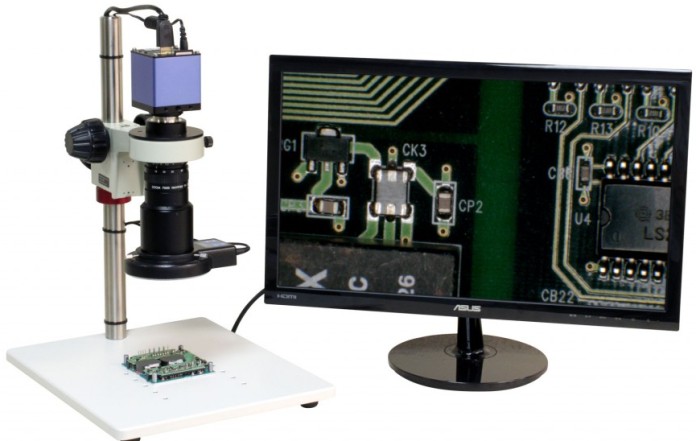Categories: How does it work
Number of views: 1785
Comments on the article: 0
Digital microscope - device and principle of operation
A digital microscope, like a conventional microscope, is used to optically magnify small objects that a person cannot see with the naked eye. However, unlike a conventional microscope, a digital microscope allows you to view magnified objects directly on a computer monitor or on your own LCD display.
A digital microscope, being a desktop or portable device of a small size, perfectly conveys the boundaries, color and shape of the object being studied, as well as its smallest elements (depending on the characteristics of a particular device).

Digital microscope
In practice, an image of a small object of interest can be obtained digitally in several ways. Most often this is realized by shooting with a digital camera. In the best (and expensive) case, the device includes a microscope, an optical adapter, a digital camera and special software.
Of course, the cost of a professional digital microscope is relatively high. An optical microscope with a built-in photoelectric sensor, which is arranged somewhat differently, is more affordable: the photoelectric sensor is built directly into the eyepiece of the device, just like it is done in digital cameras, that is, the simplest digital microscope is a modification of a digital camera.
The software supplied with the microscope allows the user to observe objects, analyze the data received on the monitor, distinguish small details, for example, on coins and jewelry, perform manipulations when soldering microcircuits, perform preparation, and in general, perform a wide variety of small works.
In addition, you can save the intermediate and final results of laboratory tests in the form of images on a computer, as well as save them to media, send them via the Internet, etc. And of course, edit and analyze the resulting images.

Usually, the better the characteristics of a digital microscope, the higher its cost. The price range for today's widely available digital microscopes ranges from $ 30 to $ 3,000. The price depends on the quality of the optics used, on the resolution and type of the sensitive matrix, on the maximum optical magnification (from 4x to 60x and more), on the quality of the materials used, on the complexity of the software, etc. It is convenient if the microscope is equipped with its own LCD or LED - high resolution display.
Benchtop Digital Microscope

The main component of a bench-top digital microscope is its head with a stage. The table is usually equipped with a pair of light sources - upper side and through the bottom. The head part has a rotating mechanism usually with three lenses of varying degrees of magnification (up to 1000 or more times), an image sensor and a panel with connectors for outputting digital images.
The procedure is as follows. The object of study is placed on a glass slide, glass, in turn, is placed on a slide. After that, the lighting is adjusted: through transparent lower illumination is used for transparent objects, the upper side is used for opaque, sometimes it is convenient to use both light sources. First use a less sensitive lens, then, if necessary, switch to a higher sensitivity.
Portable digital microscope

The simplest portable digital microscope is an optical instrument in a plastic case with a built-in CCD-matrix. It has manual focus and a simple LED backlight system. All data is transmitted via a USB cable, and the microscope is also powered by it.For convenience, the stand provided in the kit is useful.
See also at bgv.electricianexp.com
:
